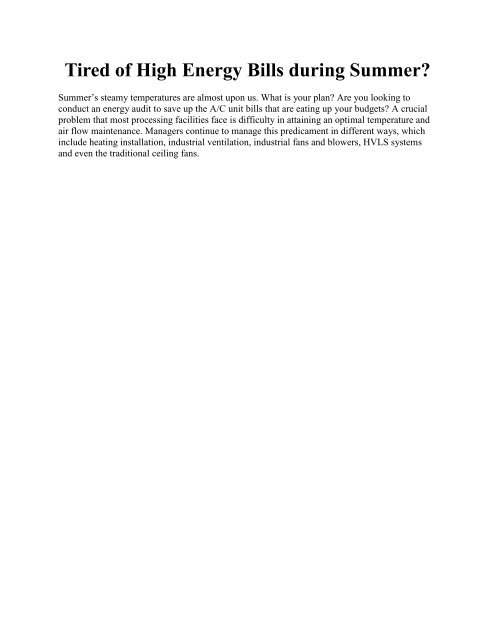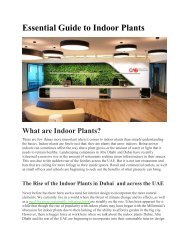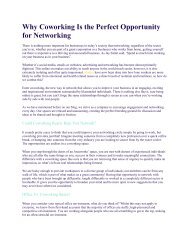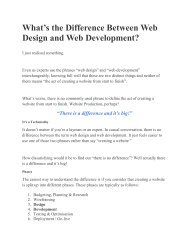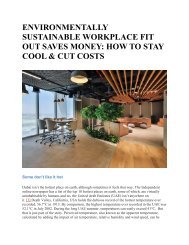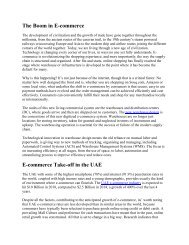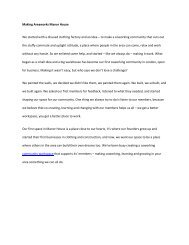Tips to Lower Your Energy Bills During Summer - HVLS Fans | Loc8
Reduce your warehouse's energy consumption during summer by installing high-volume, low-speed (HVLS) fans. Read our tips to lower your high-energy bills.
Reduce your warehouse's energy consumption during summer by installing high-volume, low-speed (HVLS) fans. Read our tips to lower your high-energy bills.
Create successful ePaper yourself
Turn your PDF publications into a flip-book with our unique Google optimized e-Paper software.
Tired of High <strong>Energy</strong> <strong>Bills</strong> during <strong>Summer</strong>?<br />
<strong>Summer</strong>’s steamy temperatures are almost upon us. What is your plan? Are you looking <strong>to</strong><br />
conduct an energy audit <strong>to</strong> save up the A/C unit bills that are eating up your budgets? A crucial<br />
problem that most processing facilities face is difficulty in attaining an optimal temperature and<br />
air flow maintenance. Managers continue <strong>to</strong> manage this predicament in different ways, which<br />
include heating installation, industrial ventilation, industrial fans and blowers, <strong>HVLS</strong> systems<br />
and even the traditional ceiling fans.
Nonetheless, there has been an increased use of high volume, low speed (<strong>HVLS</strong>) fans by most<br />
facility opera<strong>to</strong>rs. Its air movement efficiency and creating work comfort environment has<br />
elevated its use. A drawback, however, is that it’s not as convenient as the use of a regular AC<br />
thermostat alteration which temperatures can be changed at a switch.
But the question is whether there are excellent measures or technological systems that you can<br />
use <strong>to</strong> manage the skyrocketing energy costs this summer. Keeping a warehouse cool, for<br />
example, is done by a simple modification in air movement. This cannot be achieved by every<br />
cooling system in the market. The best fan is one that works with less energy, hence saving your<br />
electric bills. High Volume Low Speed (<strong>HVLS</strong>) fans work this way. They move huge columns of<br />
air, hence circulating air throughout the facility. They’re also known as Big <strong>Fans</strong>, which is true<br />
because the largest of these has a 24-feet diameter.<br />
Best for both hot and cold kinds of weather, <strong>HVLS</strong> fan will render your warehousing solutions<br />
by creating consistent temperatures. <strong>During</strong> summer’s hot temperatures, enacting the use of these<br />
big fans could reduce the temperature of your facility by 10 degrees. Their energy efficiency is<br />
undisputed as compared <strong>to</strong> hi-speed fans because of their minimal amp draw. You could even<br />
run these big daddies on solar <strong>to</strong> save up on electric bill costs.<br />
Keeping cool with <strong>HVLS</strong><br />
Health-related risks could arise <strong>to</strong><br />
both employees and patrons of a facility due <strong>to</strong> excess heat in the surrounding. A fac<strong>to</strong>ry or firm<br />
can be affected directly as a result of exhaustion, temperature, and other heat-related<br />
complications. This is <strong>to</strong> say in other words that such complications create regula<strong>to</strong>ry migraines<br />
that primarily affects the roots of the firm. In return, the firm’s morale and productivity are<br />
lowered.
The best case would be adding air- conditioning <strong>to</strong> your building though it would not be practical<br />
in consideration <strong>to</strong> configuration buildup and initial cost. <strong>HVLS</strong> fans are a great source of benefit<br />
<strong>to</strong> buildings which are in<strong>to</strong>lerant <strong>to</strong> the heat menace, whether they possess A/C or not.<br />
<strong>Fans</strong> that are floor mounted have induced wind speed that causes risks. In addition <strong>to</strong> that, they<br />
pose additional stress because the level of their operation is noisy and nagging. In comparison <strong>to</strong><br />
floor mounted fans, <strong>HVLS</strong> gives a more pleasant and pristine gentle breeze, saving relative<br />
energy. 7- 11 degrees F is a relaxing sensation made by airspeed of about 2-3 mph. For this <strong>to</strong><br />
work effectively, an 84F effective temperature has <strong>to</strong> be dropped significantly <strong>to</strong> about 73F. To<br />
drop this 84F <strong>to</strong> 73F, a 3mph moving fan has <strong>to</strong> be added. Air moving at a higher speed of more<br />
than 5mph does not give out any appealing air breeze but rather proves <strong>to</strong> be disruptive.<br />
<strong>HVLS</strong> fans are technically advanced <strong>to</strong> move large capacity of air <strong>to</strong> areas of 22000 sf. This way<br />
it replaces fans of up <strong>to</strong> a <strong>to</strong>tal of 10 -20 floors, reducing cases of mishaps and ground clatters.<br />
A/C systems become effectively efficient when the air is mixed by using low <strong>HVLS</strong> fans. By<br />
this, they are made <strong>to</strong> function at a reduced set-point.<br />
Avoid heat stress this summer while saving <strong>to</strong>o<br />
Heat stress could be manifested in various ways. No matter how minute such problems may<br />
seem, they are quite dangerous. Heat fatigue which is a less critical condition happens <strong>to</strong> drain<br />
away the workers’ concentration as well as lowering their output. Apart from heat fatigue,<br />
another condition known as heat rash occurs where the skin becomes irritated and agitated<br />
leading <strong>to</strong> severe pain. In this condition, the sweat ducts and glands become plugged <strong>to</strong>o.<br />
Larger muscles, for instance, the abdomen, arms, legs, and back, that are active during work may<br />
experience heat cramps as a result of the stress from the heat. Other causes might also be<br />
prolonged sweating caused typically by electrolyte imbalance and dehydration.<br />
Improving comfort while reducing energy use
In regards <strong>to</strong> its affordability and<br />
practicality, the <strong>HVLS</strong> fans have hailed increased attention. It also has shown <strong>to</strong> be a fac<strong>to</strong>r of<br />
the solution in the reduction of heat stress, air movement improvement as well as bettering the<br />
environment control. Moreover, creating a good working condition in general. Low-speed <strong>HVLS</strong><br />
fans have also appeared <strong>to</strong> be beneficial <strong>to</strong> engineers and designers by providing comfort. In<br />
addition, the fans have received recognition due <strong>to</strong> their ability <strong>to</strong> control the energy cost and<br />
increasing the employee’s output and productivity. It should be clearly known that <strong>HVLS</strong> fans<br />
have <strong>to</strong> be analyzed carefully on the type of fan design <strong>to</strong> capitalize on the merits.<br />
An indication of a company’s or an industry’s serious management is how much zeal and will<br />
they have in investing in their employees and ensuring their safety in a more professional way.<br />
Clearly, a healthy workplace signals care for the employees’ welfare and would create a good<br />
image of products they are manufacturing. All these have a direct significance on the impact on<br />
the bot<strong>to</strong>m line of an organization.<br />
Warehouse Industrial <strong>Fans</strong>: Fac<strong>to</strong>rs <strong>to</strong> consider for cooling<br />
needs prior <strong>to</strong> <strong>Summer</strong> Heat<br />
Just <strong>to</strong> have a look back question, was your facility facing any excessive heat difficulties last<br />
summer? If yes, then it is high time <strong>to</strong> consider a solution. Inadvertently, there will be a direct<br />
impact on the workers’ productivity and health in a warehouse should there be the existence of<br />
extremely high temperatures. Any subjection <strong>to</strong> excessive heat <strong>to</strong> your inven<strong>to</strong>ry of finished<br />
goods, materials and capital equipment’s conditions would be at a very high level of risk. This is<br />
why industrial fans come in handy as cost-effective and efficient solution.<br />
You would find industrial fans in a wide range of constructions and types. To select fans, look at<br />
size limitation, performance, and mounting configurations after comprehending your facility and<br />
its equipment that are in use and other fac<strong>to</strong>rs before making up your mind on the industrial fan<br />
you want <strong>to</strong> use.
Other benefits that arise from installation of industrial fans apart from improved comfort include:<br />
<br />
<br />
<br />
<br />
<br />
Steady temperatures<br />
LEED certificate Eligibility<br />
Reduced humidity<br />
<strong>Energy</strong> savings<br />
Improved HVAC efficiency<br />
Look at these 5 tips for next summer with the aim of checking utility bill and energy<br />
consumption reduction plans if you are focusing on your industry energy formulation.<br />
1. <strong>HVLS</strong> <strong>Fans</strong> and HVAC: A Perfect Relationship<br />
A linkage of installation of <strong>HVLS</strong> fan and HVAC System
At about 75 degrees, you can use your AC and still can achieve the optimum cool breeze.<br />
Always turn off your cooling system at night when you are not at your facility. Less tear and<br />
wear is impacted on an HVAC system by installing an <strong>HVLS</strong> fan.<br />
However, lack of an HVAC system in your space cannot deter <strong>HVLS</strong> fans from improving<br />
airflow. Nonetheless, making these two fans work <strong>to</strong>gether could yield good results in cooling<br />
your environment this hot summer. Due <strong>to</strong> <strong>HVLS</strong> fan system, it can work as a perfect<br />
conditioning complement. While HVAC fans oozes cold air in<strong>to</strong> the environment, <strong>HVLS</strong> fans<br />
works by effectively moving high volume of air – per minute. One 24′ <strong>HVLS</strong> fan can push up <strong>to</strong><br />
375,000 cubic feet. Conclusively, they are the perfect match: the cold air which is circulated by<br />
<strong>HVLS</strong> fans creates a cooling breeze of even up <strong>to</strong> 8 degrees. HVAC systems in conjunction with<br />
HVAC fans circulate air efficiently. <strong>HVLS</strong> fans of certain models can run for a minimum of 31<br />
cents per day.
The set point of the thermostat can be increased <strong>to</strong>tally dependent on your HVAC system. By<br />
doing this, there is lowering of power amount that is used <strong>to</strong> cool space. <strong>Energy</strong> consumption is<br />
decreased when there is adjusting of the thermostat. The decreased energy consumption could be<br />
up <strong>to</strong> 5%. In addition <strong>to</strong> <strong>HVLS</strong> upping health of any facility, they also add the value of a building<br />
by the regulation of temperatures. Buildings with poor air circulation have a problematic<br />
condition known as Sick Building Syndrome (SBS).<br />
For damage inven<strong>to</strong>ry, workers and equipment in a facility with lingering stagnant air, air<br />
pollutants, and harmful fumes possibly cause health risks <strong>to</strong> them. SBS is prevented by air<br />
circulation improvisation by <strong>HVLS</strong> fans that aid in pushing away air pollutants from a building.<br />
Sweating Slab Syndrome (SSS) is a complication that is encountered in buildings which can be<br />
done away with <strong>HVLS</strong> fans. SSS is caused when there is a difference of temperatures between<br />
the air surrounding the floor and the floor itself causes the buildup of moisture on floors and<br />
surfaces. It is this moisture that poses great harm <strong>to</strong> the floors’ structural integrity and the<br />
employees themselves. This is where <strong>HVLS</strong> fans come in by circulating air that helps in the<br />
reduction of deposition of water vapor on surfaces and floors.<br />
2. Tune-Up Industrial Equipment and HVAC System<br />
To have <strong>to</strong>tal control on energy cost come this summer, you will have <strong>to</strong> check your equipment<br />
of climate control in order <strong>to</strong> be assured of its functionality at any given optimal level. Anything<br />
less than that, then the AC unit probably is just wasting good energy.<br />
Moreover, forklifts, conveyors, and machines amongst other equipment burn energy. A rule <strong>to</strong><br />
consider is that anything that burns, moves or runs must be audited <strong>to</strong> ensure energy efficiency.<br />
3. Maintenance of <strong>Your</strong> Facility <strong>to</strong> prevent Air Leaks<br />
Is your fac<strong>to</strong>ry leaking air out? If yes, then there’s a no way out <strong>to</strong> reduce the consumption of<br />
energy for you.<br />
An additional tip is aiming at preventing heat via the windows of your facility. There is an<br />
existence of window coverings and treatments which typically aims at improving energy<br />
efficiency.<br />
4. Utilize Free <strong>Summer</strong> days – Emanating Natural Lighting<br />
You may want <strong>to</strong> simply maximize the bill savings of your utility by using the sun as your<br />
electric source <strong>to</strong> run your fan. Does your buildings’ design allow root skylights?<br />
Switching off the lights daytime, whenever possible, allowing natural light illumination in your<br />
facility allows you <strong>to</strong> save energy substantially.<br />
5. Carry out Fac<strong>to</strong>ry <strong>Energy</strong> Audit
An energy audit performed by an expert would make you aware of utility bills that you are<br />
incurring that can be saved or even invested <strong>to</strong> make more profits.<br />
By conducting a thorough analysis of fuel, water, and electric bills and proper exploration of a<br />
building, you are shown how <strong>to</strong> exactly create an energy plan in an aim of reducing the<br />
consumption level of your warehouse. This is done by a consultant who is energy efficiencysavvy<br />
proceeding the summer months ahead of you.<br />
The right time <strong>to</strong> start the planning of your industries’ energy is springtime, which simply means<br />
that you must be ready with a program before the weather starts <strong>to</strong> warm up in order <strong>to</strong> reduce<br />
energy costs come the humid and hot months.<br />
Take it slow with <strong>HVLS</strong><br />
However counter-intuitive it might seem, but the use of low-speed fans actually is a great source<br />
of help <strong>to</strong> buildings that have high ceilings. Courtesy of <strong>HVLS</strong>’ specially designed blades, fans<br />
can now effectively move air <strong>to</strong> places of 22,000 square feet. This is in comparison <strong>to</strong> others that
would take more than 10 <strong>to</strong> 20 fans <strong>to</strong> cover the same area coverage, not forgetting <strong>to</strong> mention<br />
the risks in conjunction with them.<br />
<strong>HVLS</strong> fans independently use low speed thus providing a more pleasing and appealing gentle<br />
breeze that poses no distraction in any given environment especially in the warehouse setting.<br />
Many different studies have proven that airspeed of 2 <strong>to</strong> 3 mph provides a sensation of cooling.<br />
This is a degree of 7- 11°F. For this <strong>to</strong> be put in perspective, an environment of 83°F is literally<br />
dropped <strong>to</strong> 72°F through an addition a 3 mph air moving fan. This simply means that HVAC<br />
systems actually do not literally have <strong>to</strong> function <strong>to</strong> provide a cooling sensation.<br />
Any worker at a warehouse industrial facility knows the importance of having a comfortable<br />
environment. Workers working under an uncomfortably hot or cold condition always experience<br />
fatigue and distraction and are error-prone consequently resulting in less productivity. They also<br />
do suffer from undermined morale and are at greater heat stress risk.<br />
Bonus benefits of Destratification<br />
<strong>HVLS</strong> ceiling fans function by slowly moving warm air low down <strong>to</strong> the floor level, in a place, it<br />
is required. This way, it reduces the effect of heat arising in levels. Thus, the air reaching the<br />
floor is naturally underneath the fans where it later moves in a horizontal direction above the<br />
floors but in just a few feet higher. Air that has eventually risen <strong>to</strong>wards the ceiling is span again<br />
downwards. This mixing effect is commonly referred <strong>to</strong> as destratification and is a crea<strong>to</strong>r of air<br />
temperature that is uniform with probably a difference of one single degree from the ceiling <strong>to</strong><br />
the floor. Warehouses or facilities that are <strong>HVLS</strong> fans equipped have a lower level of a burden<br />
because they have reduced their energy consumption, thus, saving money on the bills.<br />
Where <strong>to</strong> get these warehouse industrial fans in the UAE?<br />
Promote efficient airflow during summer by installing <strong>HVLS</strong> fans. Getting the perfect<br />
temperature <strong>to</strong> your warehouse requires an extra mile and not just having a perfect airflow.<br />
Unless your space is very small, maintaining even temperatures throughout the facility can be<br />
very challenging.<br />
Remember heated air always goes up; this can give you a clue on how <strong>to</strong> handle this issue. Heat<br />
always escapes through the ventilation of your warehouse, higher grounds of your environment<br />
either through your ceiling or vents. You would need an outside force <strong>to</strong> circulate this air faster<br />
so as <strong>to</strong> achieve that wanted temperature in summer. <strong>During</strong> cold seasons, you wouldn’t want the<br />
hot airs escaping but rather you want them brought down. <strong>HVLS</strong> fans can make this possible.<br />
And when it comes <strong>to</strong> competitive warehouse industrial fan price in the UAE, <strong>Loc8</strong>, in<br />
partnership with Rite-Hite, is your one-s<strong>to</strong>p shop industrial fan supplier in Dubai. Also, on the<br />
list of supplies include warehouse supplies and equipment, industrial ventilation and warehouse<br />
racking solutions. They will also evaluate your system and give you other alternatives. Their<br />
well-trained engineers will do all the installation work for you so no need of hiring other
technicians. With their assistance, you will achieve the desired temperature for your facility<br />
while cutting down the energy cost.<br />
Contact them <strong>to</strong>day for more enquiries about warehouse industrial fans and ventilation, or for<br />
any warehousing solutions. Call them at +971 4 368 1565 or send your requirements via email<br />
contact@loc8.ae.


